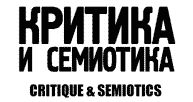A LOOK INTO THE DEPTH OF TIME: THE PHOTOGRAPHIC REPRODUCTION OF A MYTHICAL REALITY
DOI: 10.23951/2312-7899-2020-3-156-167
The essay attempts to present the art of photography as a special relationship with time. A photograph is most often seen as a fixation of the present moment. Nevertheless, it contains the entire temporal spectrum: on the one hand, it corresponds with the past, acting as its documentary evidence; on the other hand, it is always created with the prospect of subsequent viewing, i.e., in the anticipation of its completion in the future. The uniqueness of time connections in photographs lies in the fact that the present does not crowd out the past and does not give way to the future, but they all coexist on an equal basis. According to the biblical tradition, such a fullness of times was traced in life in paradise. The mythopoetic model, reconstructed on the basis of the traditional Christian doctrine of the world’s creation, suggests an absolute modus temporis. It is thought as a transitional stage from the self-identical eternity of God to the constant variability of human existence after the Fall. At first glance, the perfected technique of photography seems to be the exact opposite of the artlessness that distinguished the life of the first man. However, as the analysis shows, it is the technical capabilities of modernity that offer us special optics that can bring the lost chronotope of paradise closer. The reference of photography as the art of the new epoch, the epoch of modernity, to such archaic ideas is justified in the essay through the attraction of the philosophical reflections of Walter Benjamin. His eschatological understanding of history caused nostalgia for the ideal condition of being that was lost by mankind. This made it possible to consider photography as an artistic expression of the figurative and symbolic model of the initial time. If to apply the method of time interpretation in spatial categories Benjamin invented to photos, one can establish its important role in the (re)production of cultural meanings, reveal the secret of its attractiveness as an idealizing practice, and find its heuristic potential that opens a new perspective on the nature of time. The mythological element of the photographic art eludes the modern viewer due to excessive visualization of the world. However, it is this element that legitimizes the “archaeological” approach to the study of photography and introduces a certain element of the miraculous into the process of technical reproducibility of new media. The magic of photography manifests itself as an echo of the primeval universum, in which the divine eternity still guarantees the immortality of the current moment.
Keywords: art of photography, time, biblical model of time, image theory, Walter Benjamin, aura, modern, media
References:
Arndtz, F. (2013). Philosophie der Fotografie. Paderborn; München: Fink.
Barthes, R. (2011). Camera lucida. Kommentariy k fotografii [Camera Lucida: Reflections on Photography]. Translated from French. Moscow: Ad Marginem Press.
Benjamin, W. (2002). Proiskhozhdenie nemetskoy barochnoy dramy [The Origin of German Tragic Drama]. Translated from German. Moscow: Agraf.
Benjamin, W. (2004). Maski vremeni. Esse o kul’ture i literature [Masks of the Time. Essays on Culture and Literature] (pp. 47–234). Translated from German. Saint Petersburg: Simpozium.
Benjamin, W. (2012). Uchenie o podobii. Mediaesteticheskie proizvedeniya [The Doctrine of Similarity. Works on Media Aesthetics] (pp. 237–253). Translated from German. Moscow: RSUH.
Benjamin, W. (2013a). Kratkaya istoriya fotografii: esse [A Short History of Photography: Essays] (pp. 7–35). Translated from German. Moscow: Ad Marginem Press.
Benjamin, W. (2013b). Kratkaya istoriya fotografii: esse [A Short History of Photography: Essays] (pp. 60–116). Translated from German. Moscow: Ad Marginem Press.
Berger, J. (2014). Fotografiya i ee prednaznachenie: esse [Photography and Its Purpose: Essays] (pp. 69–79). Translated from English. Moscow: Ad Marginem Press.
Bourdieu, P., Boltanski, L., Castel, R., & Chamboredon, J.-C. (2014). Obshchedostupnoe iskusstvo: opyt o sotsial’nom ispol’zovanii fotografii [An average art: Test on the social uses of photography]. Translated from French. Moscow: Praksis.
Brodersen, M. (2005). Walter Benjamin. Frankfurt a.M.: Suhrkamp.
Cohnen, Th. (2008). Fotografischer Kosmos: der Beitrag eines Mediums zur visuellen Ordnung der Welt. Bielefeld: transcript.
Diekmann, St. (2003). Mythologien der Fotografie: Abriß zur Diskursgeschichte eines Mediums. München: Fink.
Emerling, J. (2012). Photography: History and Theory. London: Routledge.
Hirsch, M. (1997). Family Frames: Photography, Narrative and Postmemory. Cambridge, Mass.: Harvard University Press.
Jäger, L. (2017). Walter Benjamin: Das Leben eines Unvollendeten. Berlin: Rowohlt.
Jameson, F. (2014). Marksizm i interpretatsiya kul’tury [Marxism and the Interpretation of Culture] (pp. 116–136). Moscow; Yekaterinburg: Kabinetnyy uchenyy.
Petrovskaya, E. (2010). Teoriya obraza [The Theory of Image]. Moscow: RSUH.
Saussure, F. de. (1977). Trudy po yazykoznaniyu [Works on Linguistics] (pp. 31–273). Translated from English. Moscow: Progress.
Schweppenhäuser, G. (2001). Die Fluchtbahn des Subjekts (pp. 185–206). Münster: Lit.
Seel, M. (1996). Ethisch-ästhetische Studien (pp. 82–103). Frankfurt a. M.: Suhrkamp-Verlag.
Sontag, S. (1997). Mysl’ kak strast’ [Mind as Passion] (pp. 138–155). Moscow: Russkoe fenomenologicheskoe obshchestvo
Sontag, S. (2013). O fotografii [On Photography] (pp. 11–40). Moscow: Ad Marginem Press.
Issue: 3, 2020
Series of issue: Issue 3
Rubric: ESSAYS
Pages: 156 — 167
Downloads: 591










